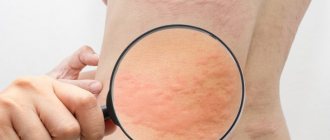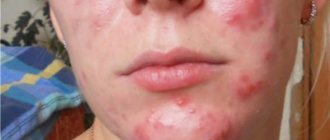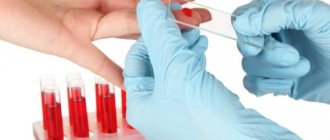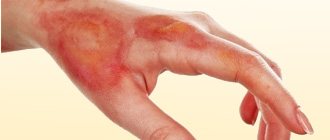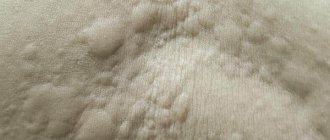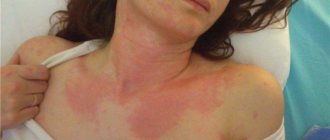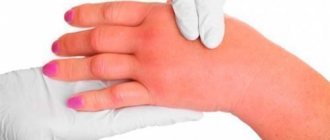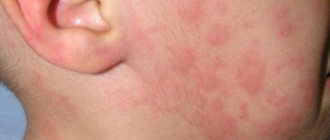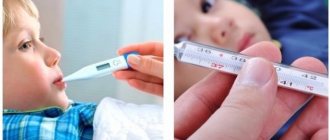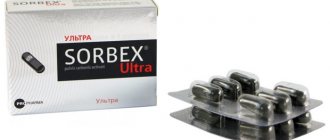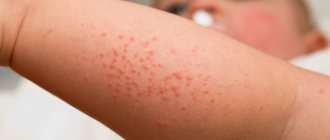Urticaria is a disease that affects the skin and mucous membranes. According to statistics, women are more likely to suffer from urticaria than men. The diagnosis that you have urticaria should be made by a dermatologist. The diagnosis is made based on the characteristic signs of urticaria and taking an anamnesis.
Attention! Hives are most often caused by the presence of an allergen. If you don't get rid of it, urticaria can become chronic due to constant contact with it. It is much more difficult to treat chronic urticaria than single urticaria.
[smartcontrol_youtube_shortcode key=”is it possible to cure urticaria of the mucous membranes” cnt=”1" col=”1" shls=”false”]
Acute urticaria. Causes
In acute urticaria, the causes of the disease in adults and children are the same:
- intolerance to drugs (antibiotics, especially penicillin type, non-steroidal anti-inflammatory drugs, sulfonamides, B-class vitamins, radiocontrast medications, anticonvulsants);
- allergies to food products (dairy, wheat, chicken, nuts and fruits, bee products, pollen, seafood, smoked meats, food additives);
- response to bee, wasp or ant venom;
- viruses (hepatitis B and C, herpes type 1, CMV, Coxsackie A and B);
- bacteria (microplasma, chlamydia, yersinia);
- parasitic creatures (such as helminths or protozoa);
- cosmetics and household powder and liquid products;
- environmental factors (overheating, solar radiation, low temperatures, wind);
- overstrain: prolonged stress, nervous breakdowns, depression.
The sooner you go to the doctor, the better. Otherwise, acute urticaria will be replaced by chronic urticaria.
Find out more
Possible complications
Acute manifestations of urticaria do not affect human organs and systems in any way. But with a long course of the disease, constant itching and rashes on the face can cause depression and other neuroses.
Edema of the larynx, accompanied by asphyxia and the risk of death, always becomes life-threatening. Therefore, the patient and the people around him must be well aware of first aid methods and constantly have access to the necessary medications.
After skin damage from scratching due to insufficient hygiene, a bacterial infection may occur. In this case, a purulent inflammatory process develops - pyoderma.
Acute urticaria. Symptoms
Acute allergic urticaria comes unexpectedly. No previous signs.
At the beginning of the disease there is a noticeable rash on the body. Dense blisters of red or soft pink shades. The edges of the lesions are clearly delineated. Occasionally, the formations have a red border separating the affected skin. The rash is accompanied by severe itching.
Blisters can be both small and large: from 1 mm to 1-3 cm. In some cases, the rashes do not appear separately, but merged with each other, forming entire affected areas.
For more serious and severe pathologies, the symptoms are:
- headache;
- unpleasant pulling sensations in the muscles;
- chills and temperature up to 39 degrees;
- nausea and vomiting.
In a number of patients, the pathology is accompanied by Quincke's edema. The most dangerous manifestation. With Quincke, predominantly the skin swells. Most often appears on the face. Sometimes - on the eyelids, which can impair vision. Less often - in the larynx area. The latter option can be fatal.
A rash is the most common option. It goes by quickly. It rarely lasts more than half a day. However, the disappearance of external symptoms does not mean the disappearance of the disease. After a period of time, the rash will appear again. Perhaps in other places.
Classification of the disease by forms and types
Hives on the hands are a common and well-studied phenomenon. The disease is divided into several forms: acute, chronic, recurrent.
It is easy to guess that the name is directly related to the symptoms and general course of development of urticaria. Most often, the rashes do not have significant manifestations and disappear quickly even without treatment. However, in such cases it is better not to “play with fire”, since acquiring a chronic form will not bring anything good to your life. If we take into account the factor that provokes the disease, then urticaria is divided into:
- spontaneous;
- mechanical;
- physical.
The most common among the population is the mechanical form, which is caused by various mechanical actions. Its manifestations are located in places where the skin most often succumbs to friction or pressure. Urticaria on the feet develops due to improperly selected shoes. Tight, small, uncomfortable shoes lead to skin irritation. The mechanical form also affects the fingers. So, constantly using a pencil and pressing it on the skin, you can see the corresponding reaction.
When your hands are affected by urticaria, it is easy to notice the appearance of a bright, red rash on the skin. In addition, external discomfort is aggravated by pain and itching.
Urticaria on the hands, the causes of which are quite varied, can be small or can reach particularly large sizes. The general condition of the affected person becomes irritable, nervous, and anxious. There is loss of sleep, frequent migraines, when going to bed, weakness, aches, and fever occur. To prevent the disease from becoming severe and bringing disastrous consequences, consult a doctor immediately if you notice signs.
Acute urticaria in children
For acute urticaria in children, treatment depends on age.
It is not recommended to take medications until 2-3 years of age. However, at any age, you can use a special menu - an elimination diet, in which certain foods are excluded.
The child should not be given:
- chocolate products;
- citruses;
- eggs;
- fish;
- canned food;
- preservatives.
Pharmacotherapy consists of prescribing antihistamines. Children's dosages are prescribed in the instructions. The medicine is prescribed by the doctor.
Note to parents:
- At the age of up to 2 years, it is acute urticaria that predominates (photos of children that can be viewed online clearly demonstrate this).
- In patients aged 2-12 years, chronic and acute forms occur, with a predominance of the latter.
- In adolescents over 12 years of age, chronic forms predominate.
- Usually the illness lasts no more than 6 weeks.
- Inpatient therapy is recommended for children from one month to three years of age.
- The acute form overwhelmingly affects children with atopic pathologies.
In children with acute urticaria, the cause of the disease in 74% of cases is food provocateurs.
Preventative measures for urticaria on the hands
Having experienced hives on your arms, palms, and fingers once, you are unlikely to want to repeat this process. Preventing a relapse is simple - just follow the doctor’s recommendations and the advice of professionals.
- Avoid medications that your doctor has told you not to take. Minimize your intake of Aspirin and Codeine. You can only take Paracetamol - it relieves pain and is safe.
- Don't forget about nutrition. The prescribed diet should become a part of your life. Eliminate spicy, alcoholic, bright and exotic foods for a while.
- Avoid temperature fluctuations. Hypothermia is just as dangerous as overheating.
- After sunbathing, lubricate your hands with cooling, nourishing creams.
Remember that hands are the first way to determine a person’s age and state of health. Be careful and take good care of your own body.
By avoiding unknown foods and products, you will protect yourself from nettle fever forever.
Acute urticaria in adults
Treatment of acute urticaria in adults is generally similar. However, in adulthood, the range of medications that can be taken orally expands.
The acute form mostly occurs in people over 45-50 years of age. Before this age, the chronic type of the disease predominates.
Despite the fact that older people have a mature body, they have a stronger and more severe course of acute urticaria (photos of symptoms and treatment are proof of this). However, even in this case, all manifestations may go away within a few hours.
Why does hives appear on the hands?
Unfortunately, the main location for urticaria is the hands. The reasons lie not only in the characteristics of the disease, but also in the human body. The appearance of a rash often results from the patient’s contact with one or another irritant or allergen. There are times when it is difficult to determine on your own which product or cosmetic causes a reaction. Therefore, the disease is divided into:
- cold, when due to a sharp drop in temperature the skin suffers some “shock”;
- aquagenic, manifested due to contact with water;
- cholinergic, when the body reacts either to a sharp increase in temperature or increased sweating: nettle fever on the legs can be provoked by tight nylon tights;
- food, when one of the products suddenly makes itself felt - this may be an isolated case, but it is possible that the irritant will have to be eliminated forever;
- the dosage form arises due to the abuse of antibiotics, tablets, and other substances;
- insect urticaria appears after insect bites - bees, fleas, bedbugs;
- the solar form of urticaria occurs due to a reaction to sunlight, ultraviolet radiation: it occurs after sunbathing, spending a long time on the beach, in a solarium - sitting for a long time in an overly sunny room can provoke the appearance of the disease;
- It is difficult to meet the adrenergic form, since it is a reaction to stressful or nervous situations;
- with idiopathic urticaria, the causes cannot be determined, despite periodic exacerbations.
It is difficult to determine on your own the severity of the disease, so a visit to a dermatologist is mandatory. Despite the traditional and common causes, there are also cases when a rash on the hands is provoked by:
- diseases of teeth and gums;
- diseases of the gastrointestinal tract, liver and endocrine system;
- the presence of chronic infectious foci (bacterial, viral, fungal);
- sarcoidosis;
- hepatitis;
- thrush or pregnancy;
- development of tumor and lymphoproliferative diseases;
- sinusitis;
- mycoplasma.
Mostly urticaria “affects” the hands of women aged 20 to 65 years. If the disease lasts more than a week, it becomes chronic.
Touching water can cause aquagenic urticaria
Treatment of acute urticaria and therapeutic methods
The acute form of urticaria is good in the early stages - then it is easily treated. If you take action at the first signs, the disease will pass quickly and without consequences.
Treatment of acute urticaria begins with eliminating the cause that caused the allergic response.
Competent treatment is comprehensive and includes three stages:
- Cleansing the body of allergens;
- Taking medications;
- Hypoallergenic diet.
Cleaning can be done in two ways: mechanical (using an enema) or medicinal (taking sorbents like activated carbon). In addition, you should drink a lot of water - filtered, room temperature and without gases. This will remove harmful substances faster.
Drug therapy includes four drug groups:
- Antihistamines. Relieves symptoms such as itching, swelling or burning.
- Calcium. Improves immunity.
- Hormonal drugs. Needed in case of complications.
- Local remedies. Creams, gels and ointments to soothe the skin.
Preparations that are applied to the skin will relieve itching, burning and redness. Usually they do not require a prescription, but they have a set of contraindications and side effects. So consultation with a doctor is mandatory. The same goes for hormonotype medications—buy only when prescribed by a doctor.
If the condition worsens, additional drugs are prescribed: anti-inflammatory, antipyretic and painkillers. They are needed only for fever, severe headaches and joint pain.
A more advanced way of treating acute urticaria is a vaccine. The patient is injected with immune blood cells. Prescribed by a doctor.
Diet should become the main therapeutic path. After all, urticaria is a pathology of the allergy type. The point is to exclude provoking products. They are calculated using tests and a test diet.
Diagnosis of mucous urticaria
If a person decides to see a doctor, the diagnosis will be made based on a visual examination and medical history. Do not forget that urticaria can only be cured when the allergen is no longer involved in a person’s life. Sometimes this is very difficult to do, since the person himself does not know what causes his allergies. To do this, the achievements of modern medicine will come to his aid. There are special tests that can be used to find out what exactly the patient is allergic to. With their help, you can figure out what causes allergies much faster, remove this factor and not have to deal with it again.
[sma[smartcontrol_youtube_shortcode key=”treatment of mucous urticaria” cnt=”1" col=”1" shls=”false”]
Diet for acute urticaria
The menu should include:
- light-colored fruits and vegetables (for example, pears and cucumbers, cabbage and zucchini);
- lean meat (except chicken);
- fermented milk;
- coarse bread.
It is advisable to exclude (potential provocateurs):
- honey;
- anything chocolate, baked goods and sodas;
- eggs, mushrooms;
- smoked and fried;
- spices.
Traditional therapy only works as an additional measure. The acute form of urticaria does not respond to them. But the symptoms can be alleviated. A few recipes from experience:
- Swamp duckweed. The grass is dried and crushed. Mix with honey. Reception - 4 times a day. Important: honey is a strong allergen, so you should consult a doctor.
- Herbal infusion. Has a sedative effect. Suitable herbs include mint, motherwort and valerian.
- Collection of herbs. Take fresh or dried parts of the following plants: St. John's wort (3 parts), immortelle flowers (4 parts), triphol leaves and tansy flowers (2 parts each), mint leaves (1 part). Pour boiling water over and let it brew. Boiling water - a glass for 1 tablespoon of the composition. Take 3 times a day before meals.
- Hepaprotective plants. To support liver function. Examples: calendula or milk thistle. Instructions for use are indicated on the package.
The quantity and dosage of drugs is prescribed by the doctor. You should also be careful with herbs - they can cause an increased reaction. You should not self-medicate.
diseases?
When you contact an expert, you will see that studying the symptoms is not enough to make a diagnosis and begin treatment. Only after identifying the cause can treatment begin. Be prepared for the diagnosis to be slow and thorough. The more thorough and thoughtful the doctor is, the better the outcome for the patient. The main diagnostic measures are:
- general and biochemical blood tests;
- tests that detect existing antibodies to infections such as hepatitis, syphilis, HIV;
- passing specific tests to exclude autoimmune diseases;
- testing for allergic reactions.
If a cold form of urticaria is likely, a small piece of ice can be applied to the body; if solar urticaria is suspected, the skin on the legs is irradiated with an ultraviolet lamp. The reaction obtained during the study provides grounds for making a diagnosis. It is also mandatory to visit doctors other than a dermatologist. Specialists such as:
- endocrinologist;
- dentist;
- otolaryngologist;
- gastroenterologist;
- gynecologist - provide the data necessary to diagnose a disease of any form.
After urticaria on the arms or legs has been identified, any doctor begins to prescribe treatment, the treatment of which determines the duration of the symptoms and the patient’s recovery.
An ultraviolet lamp will allow you to determine your reaction to solar radiation
Preventive actions
Ulcers on the mucous membrane, rashes near the mouth in women and men are, to say the least, unpleasant phenomena. And sometimes it is much easier to prevent the development of diseases. The rules of prevention are simple:
- adhere to hygiene standards;
- limit contact with infectious patients, avoid sharing dishes, towels and other household items;
- stop smoking, as cigarette smoke damages the mucous membrane of the mouth;
- try to prevent mechanical damage to the tissues of the oral cavity (for example, it is worth remembering that the food consumed should not be too hot or hard);
- use condoms during sexual intercourse.
Of course, if a rash appears on the tissues of the oral cavity or near the lips, you should consult a doctor. The sooner treatment is started, the easier it will be to cope with the disease.
source
Other causes of rash
The appearance of a rash is not always associated with infection of the body and allergic reactions. There are a number of other reasons:
- systemic lupus erythematosus (rashes near the mouth in a woman aged 15-35 years may indicate systemic, autoimmune diseases; in men the disease is diagnosed less frequently);
- immunodeficiency conditions make the body more susceptible to infection, including herpes, stomatitis, candidiasis;
- malignant neoplasms (the rash looks like nodules or ulcers).
Causes and symptoms
The manifestation of symptoms depends on the form of the disease.
Urticaria rash - description of the causes:
- Cold urticaria appears when the body cools down immediately after a few minutes. It is provoked by cool air, water, food. In 5% of patients with this form of allergy, when consuming cold foods, swelling of the larynx and tongue begins, and the condition is aggravated by fainting and suffocation. Red skin rashes are very itchy and turn into swelling.
- Solar urticaria . Sun rays are contraindicated for the patient. Lesions appear on areas of the skin exposed to ultraviolet radiation almost immediately. They go away in a couple of hours. If you do not get out of the sun, then the rash will add suffocation and heart rhythm failure. The disease occurs more often in sunny seasons (summer, spring).
- Heat urticaria .
Exhausting physical activity, stress and contact with hot water are contraindicated for this form of the disease. These and other factors cause an increase in body temperature. When the body warms up, the sufferer develops spots like urticaria with a diameter of 5 to 10 mm on the surface of the upper body. Other symptoms may be present: diarrhea, dizziness. - Demographic (mechanical) urticaria . Appears when pressure is applied to the skin in the form of irritation. For example, after a long ride with a belt, when wearing uncomfortable clothes. The rash process is accompanied by itching. The localization of the rash with urticaria is observed in the affected area and goes away 2 hours after the negative factor is eliminated.
- Vibration urticaria . A disease caused by a lack of stability of cell membranes. Patients should not work on machines that produce vibration. Symptoms disappear within a couple of hours after the cause is eliminated.
- Contact urticaria . The rash appears after contact with an allergen. It can be cream, masks and other items whose irritating substances penetrate the body through the skin. You need to remove the irritant, then the symptoms will go away.
- Cholinergic urticaria . Occurs with increased sweating in the neck, chest, face, and arms. The skin turns red, covered with red blisters. This form often occurs in the presence of diseases of the endocrine system, gastrointestinal tract and nervous disorders.
- Adrenergic urticaria . The reaction is provoked by stressful situations, which result in the release of adrenaline.
- Food urticaria . Some foods (citrus fruits, dairy, eggs, strawberries, etc.) can cause a rash. It will disappear after eliminating the allergen from the diet. Redness can occur on any part of the skin, and its area does not depend on the volume of the product eaten.
Rash in the mouth: photos, causes
Rashes in the mouth are a fairly common problem that many patients face, regardless of gender and age.
The rash can be an independent disease or appear against the background of other pathologies. Of course, the appearance of rashes negatively affects a person’s quality of life, because the pathology is often accompanied by itching, an unpleasant burning sensation and even pain. But, in order to get rid of the disease, it is worth understanding its causes. Why do rashes appear on the palate, in the mouth, around the lips? What other symptoms should you pay attention to? What treatment and prevention methods does modern medicine offer?
Types and photos of rashes in the mouth
Of course, there are many diseases accompanied by similar symptoms. Oral rashes can vary. Their structure, structure, appearance and location are important diagnostic factors.
- Bubbles are small structures whose cavity is filled with liquid, serous contents. Often such a rash in the mouth is associated with herpes.
- Pustules are structures filled with turbid contents. Inside, as a result of the inflammatory process, purulent masses form. Such rashes can be both superficial and deep.
- Blisters - this rash does not last long (for example, for several hours, sometimes even minutes). Similar lesions of the mucous membrane can be observed against the background of allergies.
- A rash may appear in the form of spots (usually reddish in color).
- Nodules are structures that do not have a cavity and are located under the superficial layers of the epidermis. Due to the formation and growth of nodules, the tissue acquires a lumpy structure.
- Scales are the result of the process of keratinization of surface tissues.
- An ulcerative rash is usually the result of damage to pustules and boils.

